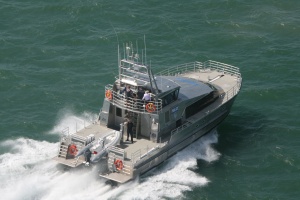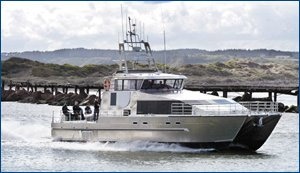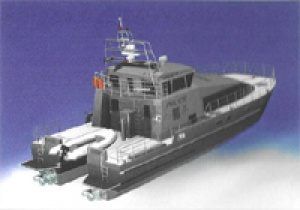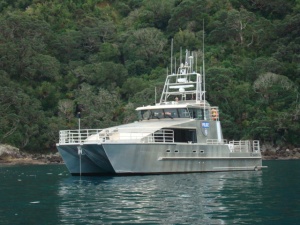
by admin | Apr 30, 2019 | Uncategorized
Central Today Newspaper December/January 2008 -Issue 47
Q-West Boat Builders Limited is expanding its already diverse skills in boat building through the construction of a $3 million vessel for the New Zealand Police.
For more information, please download the PDF file of the full article below:

by admin | Apr 30, 2019 | Uncategorized
TV3 News website
Mon, 19 Nov 2007 07:32p.m.
Boating baddies beware, the Police have just unveiled a new high speed, high-tech police boat – the Deodar III.
The vessel will be ready to start service on the Hauraki Gulf in mid December, after it finishes sea trials in the area.
The catamaran cost $2.8 million and is equipped with Hamilton jet-engines that can propel the vessel to 30 knots.
With it’s wealth of high-tech monitoring equipment, the vessel will expand sea-borne policing and search and rescue work to include customs duties.
Auckland’s first police launch was named Deodar, in honour of the warship a former police minister served.
It was commissioned in the 1960s and served until sinking in 1989 after being rammed by another ship.
Deodar II was launched in 1992 and had a long and luckier career on the Hauraki Gulf. It is hoped that Deodar III will keep the tradition alive.
Click here to view origional artilce and video

by admin | Apr 30, 2019 | Uncategorized
10.11.2007
By WILLIAM ROBERTSON
Wanganui Chronicle
A WANGANUI-built boat bound for Auckland takes with it a number of innovations that will aid maritime police work on the Waitemata Harbour.
Trials of the new police launch, Deodar III, have been �extremely successful�, according to Colin Mitchell, general manager of Q-West Boat Builders Ltd.
Senior Sergeant Martin Paget, officer in charge of the Auckland maritime police unit, they were pleased with the stable and roomy new boat.
Police had been testing the new vessel throughout this week. �We�ve found these particular boats are more than able to meet our needs, Mr Paget said.
The Deodar III is a catamaran rather than a standard single-hull vessel, and its design brought advantages.
It’s quiker, can carry more people and is easier to launch,� he said.
It was fitted with the latest electronics that police would use to locate targets and navigate with.
The large dinghy on the back of the vessel was innovative and had a particularly unusual launching capability.
Mr Paget said it would enable police to get to very shallow water more easily, board other boats with far less risk and go about discretely when necessary.
Castlecliff-based company Q-West was contracted to build all NZ police maritime vessels over the next decade. The contract represented an earning potential of $12 million.

by admin | Apr 30, 2019 | Uncategorized
By Bex Shannon, Association Communications Assistant
Maritime Unit members have voted to accept a new career structure that recognises the increased responsibility associated with their role.
On the eve of the delivery of a replacement vessel for the ageing Deodar II, Maritime Unit members will now have an incentive to acquire the advanced Police Coastal Master qualifications required to pilot the new $2.8 million vessel offshore.
Q-West Boat Builders Ltd in Wanganui is building the Deodar III. Due to be commissioned on the 30 November this year, it is a foil supported, aluminium twin-hull vessel, 18.4 metres long with a continuous service speed of 25 knots.
High performance
When you see this boat it looks like it means business. Its aesthetic look is military and patrol-like and its performance will be “very, very good too,” said Q-West General Manager, Colin Mitchell.
“The boat’s unique features are that it’s built out of high-strength aluminium, and we’re using HamiltonJet units for the propulsion system, which are made in New Zealand and have a unique electronic control system called Blue Arrow. This provides the boat with much better maneuverability than a conventional vessel.” Mr. Mitchell said.
The replacement vessel will provide increased capability to carry out all tasks currently performed by the Deodar II and will also be used in joint border-protection operations with Customs and other Government agencies in a whole of Government approach to boarder security.
One of four vessels
The boat is one of four proposed vessels Q-West has been tendered to build. Subject to funding and vessel performance, it will be the prototype for the replacement of Wellington’s Lady Elizabeth III and the New Zealand Customs’ launch, and eventually the model for the first combined New Zealand Police/Customs vessel.
The driver behind this particular boat and its design was an attempt to get a better result for the whole of Government approach to boarder protection. We have a very close and continually improving relationship with organisations such as Customs, Fisheries, and Immigration.
Ultimately, the aim is to have both Police and Customs boats as identical boats,’ said Senior Sergeant Martin Paget, of the Police Maritime Unit in Auckland.
Mr Paget is obviously looking forward to taking delivery of the vessel, having beaten a regular path to Wanganui over the past year in overseeing the vessel’s construction. “I’m really proud of the fact that this is designed and built by New Zealanders with New Zealand electronic and propulsion systems 0- it’s a bit of a buzz.”
Callouts
Every year the Deodar II responds to nearly 3,500 incidents, varying from stolen boat call-outs to search and rescue missions. Mr Paget said the new boat, including its design and technology, would address the “short-comings” of the Deodar II, which has been in service for 15 years and is simply “worn-out”.
The new boat will ensure that we can respond to and deal with emergencies quickly and efficiently, and will give us the capability to give better support to other operations like Customs. We can get people onto and off other boats safely, and carry more people at one time. Then there’s a whole range of thermal and ocean floor-mapping technology, among other things, that we use day to day,” he said.
Members of the Maritime Unit are chomping at the bit to be the first at the helm of the new vessel. However, they will first have to knuckle down and complete the advanced Police Coastal Master qualifications, necessary to operate the boat and participate in Customs-related activities.
The boat will finally hit the water in early November and will then pay a short visit to Wellington, Gisborne and Tauranga, giving the public and local police the opportunity for inspection. An official commissioning ceremony will be held in Auckland on December, celebrating the departure of the Deodar II, and the arrival of the state-of-the-art vessel.

by admin | Apr 30, 2019 | Uncategorized
New Zealand Herald
A new $2.8 million police launch will be operating in Auckland in time for summer, with a second for Wellington probably not far behind.
Auckland’s Deodar III was well advanced at a Wanganui boat builder’s yard and was due to be commissioned in Auckland on December 14, the Police Association said yesterday.
The Wellington launch, Lady Elizabeth III, was also due for replacement after nearly 20 years of service, the association said. Its predecessor sank in 1986, with the loss of two crew, Constable Glen Hughes and Sergeant Phil Ward.
The new Deodar, an 18.4m, twin-hulled aluminium boat with a top speed of 25 knots, was expected to be a prototype for the Lady Elizabeth replacement, the association said.
It would be powered by twin Hamilton jet units, expected to give it a high degree of manoeuvrability.
Deodar III, which is to replace the 15-year-old Deodar II, will also be used on customs operations and with other Government departments. The new boat is one of four expected to be built.
Senior Sergeant Martin Paget said Deodar II had become increasingly expensive to maintain.
Its successor would be launched next month for extensive sea trials in Wanganui before commissioning.
Mr Paget said a hydraulic ramp on the stern to retrieve the launch’s 4.5m rigid-hulled inflatable boat (RIB) was an impressive feature.
The ramp could be lowered to water level and the inflatable could be moved off. “Getting RIBs off a boat in anything but ideal conditions is always fraught with danger,” Mr Paget said. “It is something we have struggled with for years.”
– NZPA





